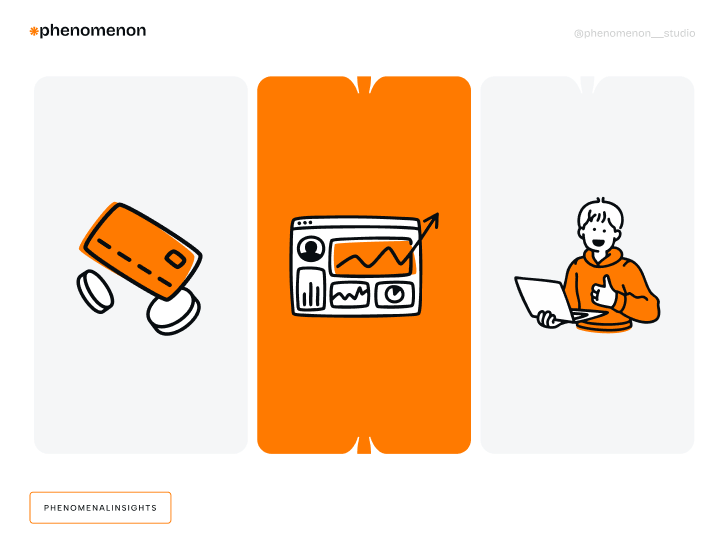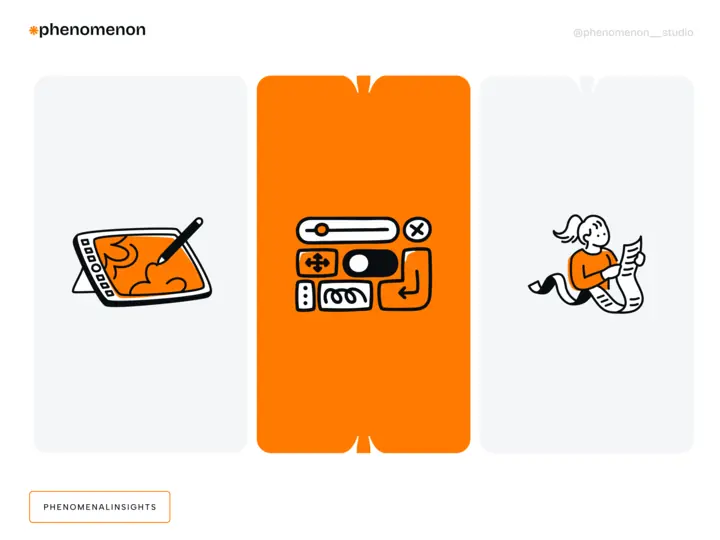Dive into User Experience (UX) Design with our comprehensive guide. Explore everything from the basics and process to career paths and future trends.
User-centricity is no longer a trend; it’s a necessity. From retail and customer service to software development and design, having the target user in mind boosts the chances of success in each industry. Gartner explains user-centricity (UX), or customer-centricity (CX), as an approach that puts the customer at the center of all decisions regarding delivering products, services, and experiences to ensure customer satisfaction, loyalty, and advocacy. Almost 73% of customers claim an excellent customer experience directly impacts their brand loyalty, while businesses that excel at CX grow their revenues to up to 8%. We could swamp you with more numbers, but it’s unnecessary. Gone are the days when decision-makers could neglect their audience’s actual needs.
UX design has also been around for ages. By adhering to its principles, designers can create software that resonates with specific target audiences, making the solution valuable and useful. But we’re not going to fold our cards yet. Stick around to learn about the best practices of user experience design, what makes it so popular, and how a talented designer can build a successful career.
What is UX Design?
At its core, UX, short for “user experience,” encapsulates a user’s journey through a website or application. It’s not just about the layout or the buttons users click; it’s about their emotions, the ease with which they accomplish tasks, and the overall satisfaction they derive from their interaction.
UX design is the wizardry behind the curtain, orchestrating a product’s functionality and adaptability while curating the emotional resonance it elicits in users. Picture a seamless interface guiding you effortlessly through a labyrinth of options, prompting you to navigate toward your desired outcome effortlessly. That’s the magic of user experience design at work.
As Steve Jobs famously said, “You’ve got to start with the customer experience and work backward for the technology. You can’t start with the technology and try to figure out where you will try to sell it.” It’s not merely about making things pretty; it’s about understanding user needs and behavior and then sculpting interfaces that cater to those needs with precision and finesse.
Consider the iconic launch of the first Macintosh in 1984. Before then, computing was dominated by arcane command lines, intimidating to even the most tech-savvy. However, Apple’s user experience designers revolutionized the landscape by introducing a graphical interface with user-friendly windows and icons. Suddenly, computing became accessible to the masses, forever changing how we interact with technology.
Read also: Navigating the Website Redesign Cost Maze for Optimal Results

UX vs UI: Clearing the Confusion
We dive into aesthetics and interaction when discussing UI (user interface). It’s like the face of a product, encompassing everything from colors, design, and animations to the buttons and forms users interact with. Think about the vibrant hues of your favorite app, the smooth transitions between screens, or even the inviting layout of a website’s homepage. UI is about making that first impression, captivating users from the moment they look at the interface.
Conversely, UX (user experience) delves deeper into emotions and functionality. It’s the journey users embark on as they navigate through a desktop application or swipe through screens on their mobile phones. Imagine the ease of booking a ride, the frustration of getting lost in a maze of menus, or the joy of seamlessly finding exactly what you need on a clutter-free website. UX is about crafting an experience that guides users effortlessly and leaves them feeling satisfied and fulfilled.
To break it down further, imagine you’re designing a car. The UI designer would decide on the steering wheel’s sleek curves and color palette, ensuring it looks stylish and inviting. Meanwhile, the UX designer would focus on how the steering wheel feels in your hands, how responsive it is to your touch, and how effortlessly it helps you navigate the road ahead.
In essence, user experience design involves identifying and solving user problems, streamlining their journey from point A to point B with minimal friction. Conversely, UI design is about crafting intuitive, aesthetically pleasing interfaces that beckon users to explore further and engage deeply with the product.
So, while UX designers meticulously analyze user behavior prototype interactions and conduct tests to ensure a seamless experience, UI designers are busy creating visually stunning interfaces that guide users. Together, they form a dynamic duo, working hand in hand to develop products that look good and feel fantastic.
Related: Why is the Discovery Stage Essential for a Successful Product?
The UX Design Process
The UX design process relies on both the design studio and the collective experiences of individual designers. However, certain stages—though they may be labeled differently—must dictate the approach taken towards their respective tasks. Here are the most common and critical ones:
Stage 1: Research
Research is the foundation of the UX design process. During this stage, designers gain an understanding of users and the context in which they will interact with the product. Designers conduct user interviews and observational studies to gather insights while analyzing competitors and industry trends. These efforts help identify opportunities and challenges. The key outcome of the research stage is to define user personas, user journeys, and design requirements that will inform subsequent process stages.
There are two types of user research: attitudinal and behavioral.
Attitudinal User Research:
This type delves into understanding the beliefs, emotions, and motivations that shape user preferences toward a product or service. Methods like surveys, interviews, and focus groups uncover insights into user attitudes and opinions, guiding strategic decisions in branding, messaging, and positioning. For instance, a software company might conduct surveys to gauge user satisfaction and identify areas for improvement in their product’s user interface, informing future design decisions.
Behavioral User Research:
Behavioral research focuses on observing and analyzing how users interact with a product or service, revealing insights into their actions, preferences, and usage patterns. Techniques such as user testing, heatmaps, and analytics provide data on user behavior, informing iterative improvements to the user experience. For example, an e-commerce platform might conduct A/B testing to compare user engagement with different checkout processes, optimizing for higher conversion rates and smoother user journeys.
Stage 2: Design
Concepts transform ideas into tangible solutions in the design stage. Designers use the insights gathered during the research phase to create wireframes, prototypes, and mockups that illustrate the product’s structure and functionality. This involves defining information architecture, interaction design, and visual design elements like layout, typography, and color scheme. Iterative design processes, such as user testing and feedback sessions, help refine and validate design decisions to ensure they align with user needs and goals.
Stage 3: Implementation
Once the design has been finalized and approved, the implementation stage involves translating the design concepts into a functional product. Developers are involved in this process, building the application’s front-end and back-end components. Collaboration between designers and developers is crucial during this stage to ensure that the design vision is accurately realized in the final product. Continuous communication and iteration may be necessary to address technical constraints and optimize user experience.
Stage 4: Evaluation
Evaluation is an ongoing process throughout the UX design lifecycle but becomes particularly critical in the final stage. During evaluation, designers conduct usability testing and gather user feedback to assess the product’s effectiveness in meeting its objectives. This involves identifying usability issues, analyzing user behavior, and measuring key performance metrics. Based on the findings, designers can make data-driven decisions to refine and improve the product iteratively. Evaluation also provides valuable insights for future iterations and enhancements to ensure the product continues to evolve to meet user needs.

The Impact of UX Design
UX design isn’t just about creating aesthetically pleasing interfaces; it’s about understanding the deeper psychology of users and leveraging that knowledge to drive business success. By crafting experiences that resonate with users on an emotional level, companies can create lasting connections that go beyond mere transactions. For example, by designing an intuitive and delightful onboarding process for a software application, companies can reduce the time it takes for users to become proficient with the product, thus increasing user retention and lifetime value. Moreover, by focusing on accessibility and inclusivity in UX design, businesses can tap into new markets and demographics, expanding their customer base and driving revenue growth in previously untapped segments.
Additionally, UX design has the power to shape how users interact with products and how they perceive and engage with the world around them. By employing principles of behavioral economics and persuasive design, UX designers can subtly influence user decisions and behaviors. For instance, by strategically placing social proof elements, such as user testimonials or ratings, within an e-commerce platform, designers can instill trust and confidence in users, leading to higher conversion rates. Furthermore, by incorporating elements of surprise and delight into the user experience, such as Easter eggs or personalized recommendations, designers can evoke positive emotions and create memorable moments that foster long-term engagement and loyalty. Ultimately, UX design has the potential to transform mundane interactions into meaningful experiences that leave a lasting impact on users’ lives.
Tools and Technologies in UX Design
Even though you have the freedom to choose the best tools for you as a designer, this list includes the most popular and reliable names that resonate with most:
- Wireframing Tools (e.g., Sketch, Adobe XD, Figma): These tools are essential for creating low-fidelity prototypes and wireframes, allowing designers to quickly iterate on design concepts and visualize the layout and structure of a product. They are useful for initial design exploration and collaboration with stakeholders.
- Prototyping Tools (e.g., InVision, Axure, Proto.io): Prototyping tools enable designers to create interactive prototypes that simulate the user experience of a product. They are helpful for user testing, gathering feedback, and validating design decisions before development. However, they may not be suitable for complex animations or interactions.
- User Research Tools (e.g., UserTesting, Optimal Workshop, Hotjar): These tools facilitate user research activities such as usability testing, surveys, and heatmaps, allowing designers to gather insights into user behavior and preferences. They are useful for understanding user needs and identifying areas for improvement in the user experience.
- Collaboration Tools (e.g., Slack, Microsoft Teams): Collaboration tools facilitate communication and teamwork among designers, developers, and other stakeholders involved in the UX design process. They are helpful for sharing ideas, providing feedback, and coordinating tasks, particularly in remote or distributed teams.
- Version Control Systems (e.g., GitHub, GitLab, Bitbucket): Version control systems allow designers to manage and track changes to design files and collaborate with team members on design projects. They are useful for maintaining a history of revisions, resolving conflicts, and ensuring consistency across design iterations.
- Accessibility Tools (e.g., Axe, Wave, Chrome DevTools): Accessibility tools help designers identify and address accessibility issues in their designs, ensuring that products are usable by people with disabilities. They are helpful for conducting accessibility audits, testing for compliance with accessibility standards, and improving the inclusivity of the user experience.
- Analytics Tools (e.g., Google Analytics, Mixpanel, Adobe Analytics): Analytics tools provide insights into user behavior and interactions within a product, helping designers make data-driven decisions to optimize the user experience. They are useful for tracking key performance metrics, identifying user pain points, and measuring the impact of design changes over time.
Conclusion
UX design is such a big part of Phenomenon expertise that we could go on endlessly about this. But it’s time to wrap up.
At Phenomenon Studio, we believe UX design is more than just a profession—it’s a journey of discovery, empathy, and creativity. It’s also about connecting with users on a deeper level, anticipating their needs, and crafting experiences that resonate. The true essence of UX design lies not in pixels or code but in the meaningful connections forged between people and the digital world.
FAQs
What is the average salary for a UX designer?
The average salary for a UX designer varies, but in the United States, it typically ranges from $60,000 to $120,000 annually, depending on location and experience.
How long does it take to become proficient in UX design?
Becoming proficient in UX design can take six months to two years, depending on individual learning pace and dedication to practice and study.
Can UX design be self-taught?
Yes, UX design can be self-taught using online resources such as articles, tutorials, and courses, although formal education programs can also provide structured learning experiences.
What is the difference between UX design and graphic design?
The main difference between UX design and graphic design lies in their focus: UX design centers on optimizing user experience and functionality, while graphic design emphasizes visual aesthetics and communication.













